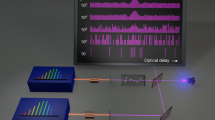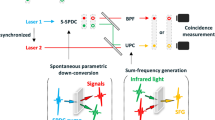Abstract
Identifying strong and fast nonlinearities for today's photonic applications is an ongoing effort1. Materials2,3,4,5 and devices6,7,8,9 are typically sought to achieve increasing nonlinear interactions. We report large enhancement of two-photon absorption through intrinsic resonances using extremely non-degenerate photon pairs. We experimentally demonstrate two-photon absorption enhancements by factors of 100–1,000 over degenerate two-photon absorption in direct-bandgap semiconductors. This enables gated detection of sub-bandgap and sub-100 pJ mid-infrared radiation using large-bandgap detectors at room temperature. Detection characteristics are comparable in performance to liquid-nitrogen-cooled HgCdTe (MCT) detectors. The temporal resolution of this gated detection by two-photon absorption is determined by the gating pulse duration.
This is a preview of subscription content, access via your institution
Access options
Subscribe to this journal
Receive 12 print issues and online access
$209.00 per year
only $17.42 per issue
Buy this article
- Purchase on Springer Link
- Instant access to full article PDF
Prices may be subject to local taxes which are calculated during checkout


Similar content being viewed by others
Change history
03 December 2021
A Correction to this paper has been published: https://doi.org/10.1038/s41566-021-00930-8
References
Haque, S. A. & Nelson, J. Toward organic all-optical switching. Science 327, 1466–1467 (2010).
Yumoto, J. et al. Enhancement of optical nonlinearity of heavy‐metal oxide glasses by replacing lead and bismuth with thallium. Appl. Phys. Lett. 63, 2630–2632 (1993).
Sasaki, F., Kobayashi, S. & Haraichi, S. Enhancement of the optical nonlinearity in pseudoisocyanine J aggregates embedded in distributed feedback microcavities. Appl. Phys. Lett. 81, 391–393 (2002).
Soljačić, M. & Joannopoulos, J. D. Enhancement of non-linear effects using photonic crystals. Nature Mater. 3, 211–219 (2004).
Hales, J. M. et al. Design of polymethine dyes with large third-order optical nonlinearities and loss figures of merit. Science 327, 1485–1488 (2010).
Genevet, P. et al. Large enhancement of nonlinear optical phenomena by plasmonic nanocavity gratings. Nano Lett. 10, 4880–4883 (2010).
Schuller, J. A. et al. Plasmonics for extreme light concentration and manipulation. Nature Mater. 9, 193–204 (2010).
Capasso, F., Sirtori, C. & Cho, A. Y. Coupled quantum well semiconductors with giant electric field tunable nonlinear optical properties in the infrared. IEEE J. Quantum Electron. 30, 1313–1326 (1994).
Paiella, R. et al. Self-mode-locking of quantum cascade lasers with giant ultrafast optical nonlinearities. Science 290, 1739–1742 (2000).
Tanabe, T., Notomi, M., Kuramochi, E., Shinya, A. & Taniyama, H. Trapping and delaying photons for one nanosecond in an ultrasmall high-Q photonic crystal nanocavity. Nature Photon. 1, 49–52 (2007).
Christodoulides, D., Khoo, I. C., Salamo, G. J., Stegeman, G. I. & Van Straland, E. W. Nonlinear refraction and absorption: mechanisms and magnitudes. Adv. Opt. Photon. 2, 60–200 (2010).
Said, A. A. et al. Determination of bound-electronic and free-carrier nonlinearities in ZnSe, GaAs, CdTe, and ZnTe. J. Opt. Soc. Am. B 9, 405–414 (1992).
Hutchings, D. C. & Van Stryland, E. W. Nondegenerate two-photon absorption in zinc blende semiconductors. J. Opt. Soc. Am. B 9, 2065–2074 (1992).
Sheik-Bahae, M., Wang, J., DeSalvo, R., Hagan, D. J. & Van Styland, E. W. Measurement of nondegenerate nonlinearities using a two-color z scan. Opt. Lett. 17, 258–260 (1992).
Sheik-Bahae, M., Hutchings, D. C., Hagan, D. J. & Van Stryland, E. W. Dispersion of bound electronic nonlinear refraction in solids. IEEE J. Quantum Electron. 27, 1296–1309 (1991).
Wherrett, B. S. Scaling rules for multiphoton interband absorption in semiconductors. J. Opt. Soc. Am. B 1, 67–72 (1984).
Olszak, P. D. et al. Spectral and temperature dependence of two-photon and free-carrier absorption in InSb. Phys. Rev. B 82, 235207 (2010).
Hales, J. M. et al. Resonant enhancement of two-photon absorption in substituted fluorine molecules. J. Chem. Phys. 121, 3152–3160 (2004).
Pati, S. K., Marks, T. J. & Ratner, M. A. Conformationally tuned large two-photon absorption cross sections in simple molecular chromophores. J. Am. Chem. Soc. 123, 7287–7291 (2001).
Kogej, T. et al. Mechanisms for enhancement of two-photon absorption in donor–acceptor conjugated chromophores. Chem. Phys. Lett. 298, 1–6 (1998).
Kleinman, D. A. & Boyd, G. D. Infrared detection by optical mixing. J. Appl. Phys. 40, 546–566 (1969).
Gurski, T. R., Epps, H. W. & Maran, S. P. Upconversion of broadband infrared spectra. Appl. Opt. 17, 1238–1242 (1978).
Watson, E. A. & Morris, G. M. Comparison of infrared upconversion methods for photon-limited imaging. J. Appl. Phys. 67, 6075–6084 (1990).
Hadfield, R. H. Single-photon detectors for optical quantum information applications, Nature Photon. 3, 696–705 (2009).
Gu, X. et al. Temporal and spectral control of single-photon frequency upconversion for pulsed radiation, Appl. Phys. Lett. 96, 131111 (2010).
Thew, R. T., Zbinden, H. & Gisin, N. Tunable upconversion photon detector. Appl. Phys. Lett. 93, 071104 (2008).
Urbach, F. The long-wavelength edge of photographic sensitivity and of the electronic absorption of solids. Phys. Rev. 92, 1324 (1953).
Wu, J. & Luo, F. Ultrafast femtosecond all-optical modulation through nondegenerate two-photon absorption in silicon-on-insulator waveguides. J. Russian Laser Res. 29, 490–496 (2008).
Vahala, K. J. Optical microcavities. Nature 424, 839–846 (2003).
Leuthold, J., Koos, C. & Freude, W. Nonlinear silicon photonics. Nature Photon. 4, 535–544 (2010).
Apiratikul, P. & Murphy, T. E. Background-suppressed ultrafast optical sampling using nondegenerate two-photon absorption in a GaAs photodiode. IEEE Photon. Technol. Lett. 22, 212–214 (2010).
Boitier, F., Dherbecourt, J. B., Godard, A. & Rosencher, E. Infrared quantum counting by nondegenerate two photon conductivity in GaAs. Appl. Phys. Lett. 94, 081112 (2009).
Hayat, A., Ginzburg, P. & Orenstein, M. Infrared single-photon detection by two-photon absorption in silicon. Phys. Rev. B 77, 125219 (2008).
Hayat, A., Ginzburg, P. & Orenstein, M. Observation of two-photon emission from semiconductors. Nature Photon. 2, 238–241 (2008).
Delfyett, P. J. Optical frequency combs from semiconductor lasers and applications in ultrawideband signal processing and communications. J. Lightwave Technol. 24, 2701–2719 (2006).
Chow, P. P. et al. Group III—nitride materials for ultraviolet detection applications. SPIE: Optoelectronics Conference Proceedings, 3948–32 (2000).
Pugh, S. K., Dugdale, D. J., Brand, S. & Abram, R. A. Electronic structure calculations on nitride semiconductors. Semicond. Sci. Technol. 14, 23–31 (1999).
Bass, M., Li, G. & Van Stryland, E. W. Handbook of Optics: Volume 4, Optical Properties of Materials, Nonlinear Optics, Quantum Optics 3rd edn (McGraw-Hill, 2010).
Sheik-Bahae, M., Hutchings, D. C., Hagan, D. J. & Van Stryland, E. W. Dispersion of bound electronic nonlinear refraction in solids. IEEE J. Quantum Electron. 27, 1296–1309 (1991).
Acknowledgements
This work was supported in part by the US Army Research Office (grant no. 50372-CH-MUR) and the DARPA ZOE program (grant no. W31R4Q-09-1-0012).
Author information
Authors and Affiliations
Contributions
D.A.F., C.M.C., L.A.P. and S.W. conceived and performed the experiments. C.M.C and D.A.F. modelled the data and performed the theoretical analysis. M.M. designed and implemented the detection system. D.J.H. and E.W.V.S. suggested the basic concept of enhanced ND-2PA for experiments and applications. All authors contributed to the discussion of the results and writing the paper.
Corresponding author
Ethics declarations
Competing interests
The authors declare no competing financial interests.
Supplementary information
Supplementary information
Supplementary information (PDF 283 kb)
Rights and permissions
About this article
Cite this article
Fishman, D., Cirloganu, C., Webster, S. et al. Sensitive mid-infrared detection in wide-bandgap semiconductors using extreme non-degenerate two-photon absorption. Nature Photon 5, 561–565 (2011). https://doi.org/10.1038/nphoton.2011.168
Received:
Accepted:
Published:
Issue Date:
DOI: https://doi.org/10.1038/nphoton.2011.168
This article is cited by
-
Mid-infrared single-photon 3D imaging
Light: Science & Applications (2023)
-
Wide-field mid-infrared single-photon upconversion imaging
Nature Communications (2022)
-
Methodology of optimisation for a nanostructured two-photon absorption photodetector
Journal of the European Optical Society-Rapid Publications (2021)
-
Recent advances in high-figure-of-merit semiconductor and organic materials for all-optical switching applications
Journal of Materials Science (2021)
-
Infrared chemical imaging through non-degenerate two-photon absorption in silicon-based cameras
Light: Science & Applications (2020)



